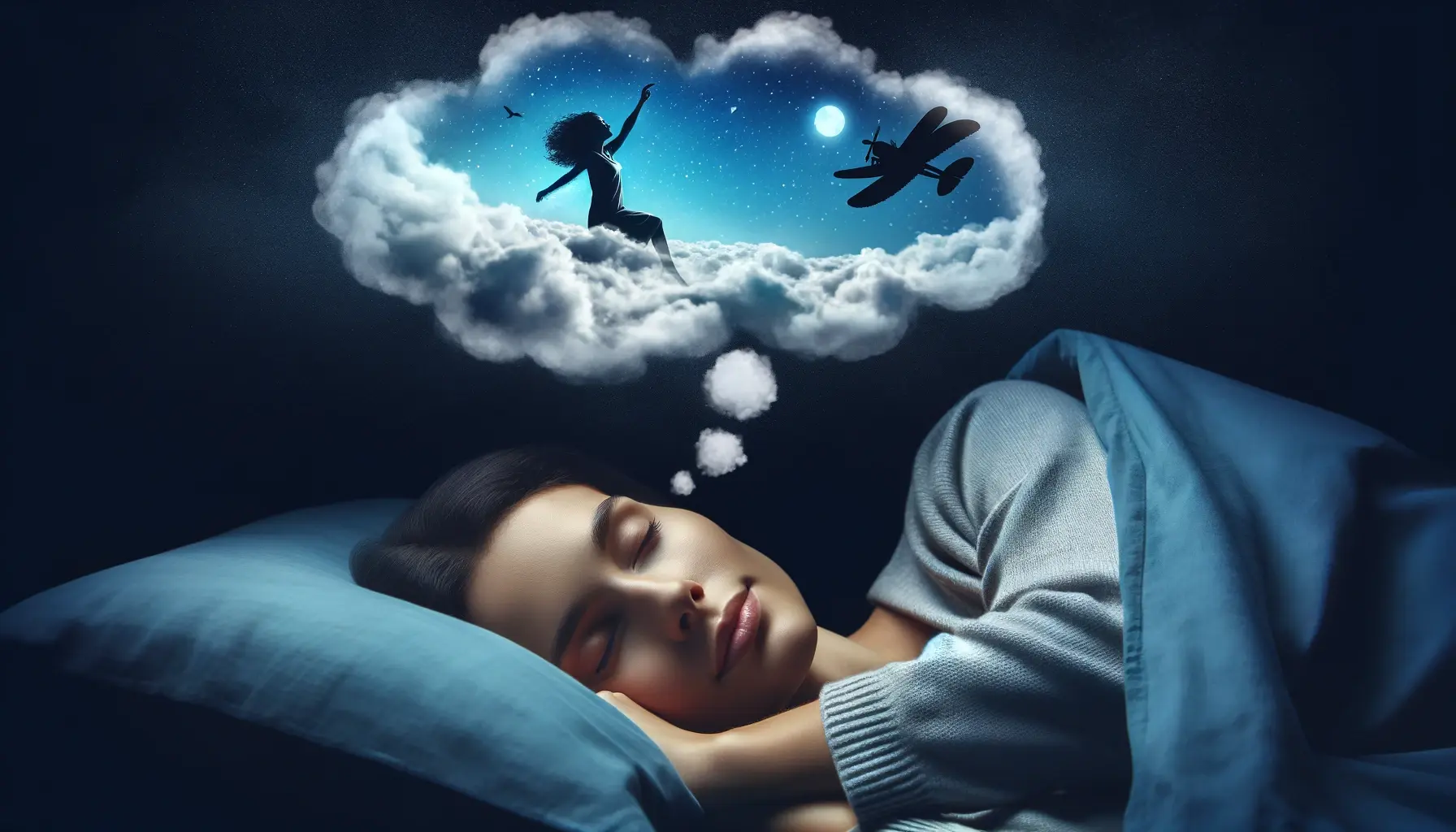Common dream themes include flying, falling, being chased, encountering animals, taking exams, and finding oneself in familiar or unfamiliar settings.
.webp)
The Science Behind Dreaming

2 Minutes Psychology
Sep 10, 2025
Dreams have always been a source of fascination, mystery, and insight. From ancient civilizations viewing dreams as messages from the gods to modern psychologists decoding the intricate web of the subconscious, dreams have remained a constant topic of intrigue. This article delves into the science behind dreaming, the historical perspectives of dream analysis, and the modern techniques employed to understand them. We'll also explore the connection between dreams and mental health and look ahead to the future of dream analysis.
The Science Behind Dreaming:
The Sleep Cycle
Sleep isn't a uniform state but is divided into various stages.
Each stage has its characteristics, with REM being the most associated with vivid dreaming.
REM (Rapid Eye Movement) Stage
Occurs multiple times during a night's sleep, with each REM phase lasting longer than the previous one.
Characterized by:
- o Rapid movement of the eyes.
- o Increased brain activity.
- o Vivid dreams.
- o Temporary muscle paralysis, preventing us from acting out our dreams.
Neurotransmitters and Dreaming
Neurotransmitters are chemicals that transmit signals in the brain.
Key neurotransmitters involved in sleep and dreaming include:
- Serotonin: Regulates mood, appetite, and sleep. Its levels decrease during REM, possibly contributing to the emotional content of dreams.
- Norepinephrine: Influences alertness and arousal. Reduced levels during REM might be linked to the dreamlike state and emotional intensity.
Purpose and Theories of Dreaming
- Memory Consolidation: Some researchers believe dreaming helps process and store memories. REM sleep might help integrate new information with existing knowledge.
- Emotional Regulation: Dreams might serve as a coping mechanism, allowing us to process emotions and traumas in a safe environment.
- Cognitive Development: Dreams might aid in problem-solving and fostering creativity.
- Neural Connection: Dreaming might help in the development and pruning of neural pathways, ensuring brain health and functionality.
The Ongoing Debate
Despite extensive research, the exact purpose of dreaming remains elusive.
Different theories might coexist, suggesting dreams have multiple functions beneficial to our psychological and neurological well-being.
Historical Perspectives on Dream Analysis: Freud vs. Jung
The Pioneers of Dream Analysis
Dream analysis isn't a modern concept; it has ancient roots. However, in the realm of psychology, two names stand out: Sigmund Freud and Carl Jung.
Sigmund Freud's Interpretation
- Repressed Desires: Freud believed that dreams are the "royal road to the unconscious." They serve as outlets for desires that we've suppressed or repressed.
- Childhood Origins: Many of these repressed desires, according to Freud, have their origins in childhood and can influence adult behavior.
- Sexual Nature: Freud's dream theory often emphasized the sexual nature of dreams, categorizing them into latent (hidden meanings) and manifest (obvious content) content.
- Wish-Fulfillment: He proposed that dreams are a form of wish-fulfillment, where our unconscious desires manifest in symbolic forms.
Carl Jung's Perspective
- Collective Unconscious: Unlike Freud, who focused on the personal unconscious, Jung introduced the idea of the "collective unconscious." This is a shared reservoir of experiences and symbols common to all humans.
- Archetypes: Jung believed that dreams contain archetypes, which are universal symbols or motifs. Examples include "The Hero," "The Mother," and "The Shadow."
- Personal vs. Universal: While Freud's dream analysis was more personal and individualistic, Jung's approach was holistic, emphasizing the shared human experience.
Divergence in Views
While both Freud and Jung agreed on the significance of dreams, their interpretations varied. Freud's was more centered on individual sexual and repressed desires, while Jung's encompassed broader human experiences and shared symbols.
Lasting Impact
Both Freud and Jung's theories have left a lasting legacy in dream analysis. Modern dream interpretation often borrows from both, recognizing the individual's personal experiences while also acknowledging shared human symbols and stories.
Common dreams and their meanings:
Certain dream motifs are almost universal. For instance:
- Falling: Often linked to feelings of insecurity, loss of control, or potential failures.
- Flying: Typically represents desires for freedom, ambition, or escaping certain situations.
- Being Chased: This can indicate avoidance, running away from problems, or feelings of threat.
Dreams of loss or failure might mirror real-life anxieties, while dreams of success or triumph can reflect our aspirations and hopes.
(For further visit https://letsmeet.2minutespsychology.com/threads)
Modern Techniques in Dream Analysis
The field of dream analysis has witnessed significant advancements in recent years. Unlike the early days where interpretations were largely based on psychoanalytic theories, modern techniques are more diverse and data-driven.
Cognitive Dream Analysis:
- Overview: This approach is rooted in cognitive psychology and emphasizes the mental processes that occur during dreaming. It focuses on how we process information, solve problems, and think in our dreams.
- Application: Therapists might explore the dreamer's thought patterns, beliefs, and attitudes within the dream to understand their waking cognitive processes.
Dream Journals:
- Overview: A time-tested method, dream journals involve recording dreams as soon as one wakes up. This practice captures the dream's details before they fade.
- Benefits: Over time, patterns might emerge, providing valuable insights into recurring themes, symbols, or emotions. This raw material becomes a rich source for analysis.
Technological Innovations:
- Dream Analysis Apps: Leveraging AI, these apps can offer instant interpretations by comparing dream elements to vast databases of dream symbols and meanings.
- Virtual Reality (VR): VR is being explored as a medium to recreate dream scenarios. This immersive experience allows individuals to revisit their dreams, offering a unique perspective and deeper analysis.
Dreams and Mental Health
Dreams can be reflective mirrors, often revealing the state of our mental and emotional health.
Nightmares and Trauma:
- Connection: Persistent nightmares, especially those that replay traumatic events, can be indicative of Post-Traumatic Stress Disorder (PTSD).
- Therapeutic Implications: Recognizing these patterns can be crucial in diagnosing PTSD, leading to targeted therapeutic interventions.
Anxiety Dreams:
Overview: Dreams filled with anxious scenarios, feelings of being trapped, or overwhelming challenges might mirror daily stresses or deeper-rooted anxieties.
Role in Therapy: By dissecting these dreams, therapists can pinpoint specific anxieties or stressors, guiding the therapeutic process and helping individuals address their underlying concerns.
The Future of Dream Analysis
As with many fields, technology and scientific advancements promise to reshape the landscape of dream analysis.
AI in Dream Interpretation:
- Potential: AI tools, backed by vast psychological and dream databases, might soon offer real-time, personalized dream interpretations, making dream analysis more accessible to the masses.
Neuroscientific Advances:
- Brain Imaging: As our tools for mapping brain activity, like fMRI and EEG, become more sophisticated, we'll gain deeper insights into brain functions during the REM stage of sleep.
- Bridging Gaps: This could lead to a more comprehensive understanding of how conscious experiences, memories, and emotions influence our dreams, providing a holistic view of the human psyche.
Summary:
Dreams are a window into our subconscious, reflecting our deepest fears, desires, and memories. The journey from understanding dreams as divine messages to decoding them with AI and advanced neuroscience show cases the evolution of human understanding. While the REM stage of sleep is most associated with vivid dreaming, the role of neurotransmitters like serotonin and norepinephrine cannot be understated. Historical giants like Freud and Jung laid the foundation for dream analysis, emphasizing repressed desires and universal symbols, respectively. Modern techniques, from cognitive dream analysis to AI-driven apps, have revolutionized the field. Furthermore, the link between dreams and our mental well-being offers therapeutic insights, helping address traumas and anxieties. As we stand on the cusp of further technological and scientific advancements, the enigma of dreams continues to beckon, promising deeper insights into the human psyche.
Community
Share your experience
Let's Meet 2 Minutes Psychology
Aug 28
Remember
Let's Meet 2 Minutes Psychology
Aug 28
Cognitive Behavioral Therapy (CBT) and anxiety coping skills
Let's Meet 2 Minutes Psychology
Aug 28
Anxiety coping skills for teens
Let's Meet 2 Minutes Psychology
Aug 28
Grounding techniques
Let's Meet 2 Minutes Psychology
Aug 28
Related Posts
Categories
FREQUENTLY ASKED QUESTIONS
What are common themes in dreams?
Why do I keep dreaming about falling?
Dreams of falling often relate to feelings of insecurity, instability, or fear of failure in one's waking life.
Can dreams predict the future?
While some believe in prophetic dreams, most psychologists view dreams as reflections of past experiences, current emotions, and subconscious thoughts rather than predictions.
How can I better understand my dreams?
Keeping a dream journal, reflecting on personal life events, and consulting dream interpretation guides or professionals can offer insights into dream meanings
.png)

